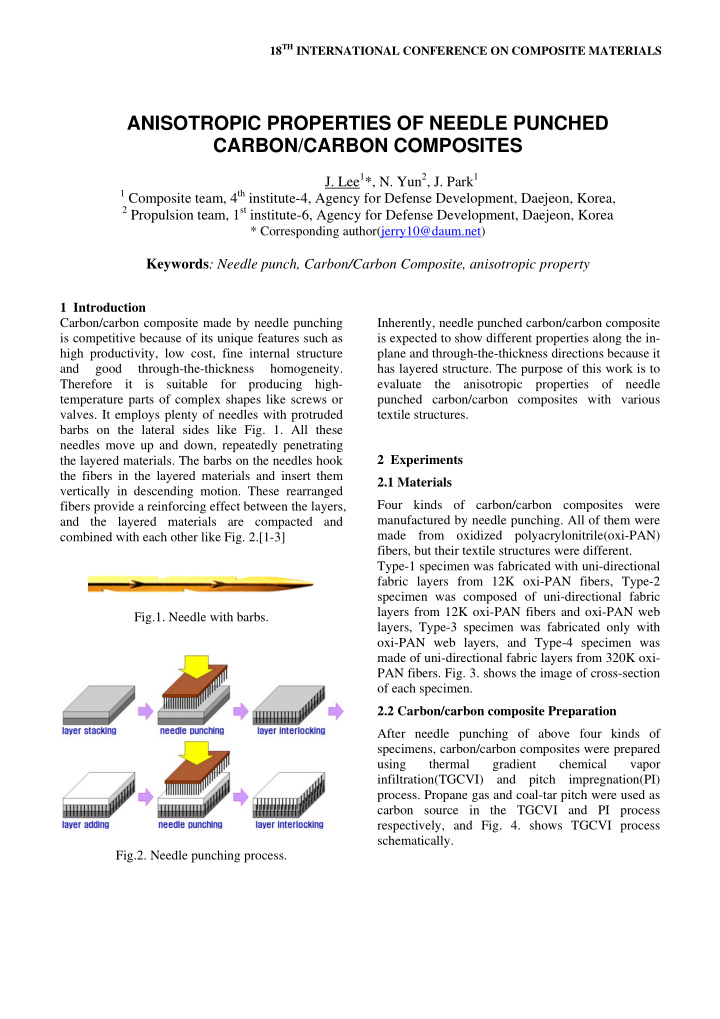



18 TH INTERNATIONAL CONFERENCE ON COMPOSITE MATERIALS ANISOTROPIC PROPERTIES OF NEEDLE PUNCHED CARBON/CARBON COMPOSITES J. Lee 1 *, N. Yun 2 , J. Park 1 1 Composite team, 4 th institute-4, Agency for Defense Development, Daejeon, Korea, 2 Propulsion team, 1 st institute-6, Agency for Defense Development, Daejeon, Korea * Corresponding author(jerry10@daum.net) Keywords : Needle punch, Carbon/Carbon Composite, anisotropic property 1 Introduction Carbon/carbon composite made by needle punching Inherently, needle punched carbon/carbon composite is competitive because of its unique features such as is expected to show different properties along the in- high productivity, low cost, fine internal structure plane and through-the-thickness directions because it and good through-the-thickness homogeneity. has layered structure. The purpose of this work is to Therefore it is suitable for producing high- evaluate the anisotropic properties of needle temperature parts of complex shapes like screws or punched carbon/carbon composites with various valves. It employs plenty of needles with protruded textile structures. barbs on the lateral sides like Fig. 1. All these needles move up and down, repeatedly penetrating 2 Experiments the layered materials. The barbs on the needles hook the fibers in the layered materials and insert them 2.1 Materials vertically in descending motion. These rearranged Four kinds of carbon/carbon composites were fibers provide a reinforcing effect between the layers, manufactured by needle punching. All of them were and the layered materials are compacted and made from oxidized polyacrylonitrile(oxi-PAN) combined with each other like Fig. 2.[1-3] fibers, but their textile structures were different. Type-1 specimen was fabricated with uni-directional fabric layers from 12K oxi-PAN fibers, Type-2 specimen was composed of uni-directional fabric layers from 12K oxi-PAN fibers and oxi-PAN web Fig.1. Needle with barbs. layers, Type-3 specimen was fabricated only with oxi-PAN web layers, and Type-4 specimen was made of uni-directional fabric layers from 320K oxi- PAN fibers. Fig. 3. shows the image of cross-section of each specimen. 2.2 Carbon/carbon composite Preparation After needle punching of above four kinds of specimens, carbon/carbon composites were prepared using thermal gradient chemical vapor infiltration(TGCVI) and pitch impregnation(PI) process. Propane gas and coal-tar pitch were used as carbon source in the TGCVI and PI process respectively, and Fig. 4. shows TGCVI process schematically. Fig.2. Needle punching process.
(a) Type-1 Fi ig.4. Therma al gradient ch hemical vapo or infiltration n. 3 R Results Me echanical an nd thermal p properties w were measure ed alo ong the in-plane i an nd through h-the-thickne ss dir rections wi ith four k kinds of c carbon/carbo on com mposites. (b) T Type-2 3.1 1 Mechanica al Propertie s Fig g. 5. shows t that tensile s strength alon ng the in-plan ne dir rection is pre etty higher th han along the e through-th e- thi ickness direc ction with a all specimen s because th he bo und fibers along th he through h-the-thickne ss dir rection are w weaker than n the aligned d fibers alon ng the e in-plane dir rection. Ty ype-2 with 12 2K oxi-PAN N fibers show ws outstandin ng ten nsile strengt th along the e in-plane d direction tha an Ty ype-3 with o oxi-PAN we eb layers or Type-4 wit th (c) Type-3 32 0K oxi-PAN N fibers for r its better alignment o of fib bers. And ox xi-PAN web layers in Ty ype-2 seem t to hav ve the syne ergy effect w with 12K ox xi-PAN fibe rs wi ith the help of fiber bi inding durin ng the need dle pu unching proce ess. Fig g. 6. shows t that compres ssive strength h along the in n- pla ane direction n is lower th han along the e through-th e- thi ickness direc ction with a all specimen s because th he com mpressive lo oad along th he in-plane direction ca an ma ake the delam mination bet tween the lay yers, which is the e weak point t of needle pu unched struc cture. Ty ype-2 shows better comp pressive stren ngth along th he (d) Type-4 thr rough-the-thi ickness dir rection beca ause of th he eff fective fiber binding betw ween 12K ox xi-PAN fibe rs Fig.3. Ima age of cross-s section of ea ach specimen an d oxi-PAN w web layers as s mentioned above.
fiber-network-structure after needle punching process like monolithic solid as shown in Fig. 3(c). Fig.5. Tensile strength of needle punched carbon/carbon composites. Fig.7. Thermal conductivity of needle punched carbon/carbon composites. 4 Conclusions With the needle punched carbon/carbon composites, it is found that the mechanical properties such as tensile strength and compressive strength are anisotropic, in other words, there are big differences along the in-plane and through-the-thickness directions with four kinds of needle punched carbon/carbon composites. Among the four kinds of needle punched carbon/carbon composites, the hybrid of uni-directional fabric of 12K oxi-PAN fibers and oxi-PAN web layer shows most effective fiber binding. Fig.6. Compressive strength of needle punched The results of thermal conductivities are not so carbon/carbon composites. anisotropic because they are not the result of fiber alignment or binding but the result of fiber and carbon matrix continuity. 3.2 Thermal Properties References Fig. 7. shows that thermal conductivities in both directions are similar, which means that they are not [1] T. Chen, J. Liao, G. Liu, F. Zhang and Q. Gong the result of fiber alignment or binding but the result “Effect of needle-punched felt structure on the of fiber and carbon matrix continuity. mechanical properties of carbon/carbon composites”. Type-3, which was made only with oxi-PAN web Carbon , Vol. 41, No. 5, pp 993-999, 2003. layers, has remarkably high thermal conductivities [2] J. Lee and T. Kang “Therrmal conductivity of needle because oxi-PAN web layers have most entangled punched performs made of carbon and oxipan fibres”. 3
Polymers and Polymer Composites , Vol. 13, No. 1, pp 83-92, 2005. [3] M. Evans, K. Williams and R. Fisher “ Manufacture of carbon fibre perform ”. US Patent 5599603, 1997.
Recommend
More recommend